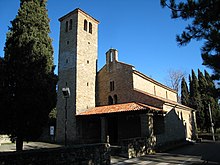
Pavia is a town and comune of south-western Lombardy, in Northern Italy, 35 kilometres south of Milan on the lower Ticino near its confluence with the Po. It has a population of c. 73,086. The city was the capital of the Ostrogothic Kingdom from 540 to 553, of the Kingdom of the Lombards from 572 to 774, of the Kingdom of Italy from 774 to 1024 and seat of the Visconti court from 1365 to 1413.
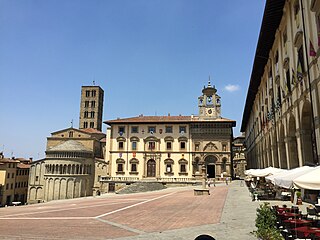
Arezzo is a city and comune in Italy and the capital of the province of the same name located in Tuscany. Arezzo is about 80 kilometres southeast of Florence at an elevation of 296 metres (971 ft) above sea level. As of 2022, the population was about 97,000.
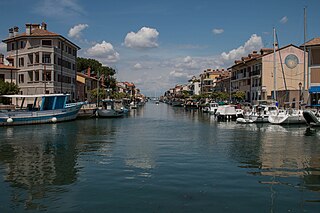
Grado is a town and comune (municipality) of 8,064 residents in the Regional decentralization entity of Gorizia in the north-eastern Italian region of Friuli-Venezia Giulia, located on an island and adjacent peninsula of the Adriatic Sea between Venice and Trieste. The territory of the municipality of Grado extends between the mouth of the Isonzo and the Adriatic Sea and the Grado Lagoon, and covers an area of about 90 square kilometers between Porto Buso and Fossalon. Characteristic of the lagoon is the presence of the casoni, which are simple houses with thatched roof used in the past by the fishermen of Grado, who remained in the lagoon for a long time, returning to the island of Grado only during the colder period of the year.

The Basilica of the Holy Cross in Jerusalem or Basilica di Santa Croce in Gerusalemme is a Catholic Minor basilica and titular church in rione Esquilino, Rome, Italy. It is one of the Seven Pilgrim Churches of Rome.

Muggia is an Italian town and comune (municipality) in south-eastern Regional decentralization entity of Trieste, in the region of Friuli-Venezia Giulia on the border with Slovenia. Lying on the eastern flank of the Gulf of Trieste in the northern Adriatic Sea, Muggia is the only Italian port town in Istria. The town's architecture is marked by its Venetian and Austrian history, and its harbour hosts a modern 500-berth marina for yachts.

The Church of Santa Maria Assunta is a basilica church on the island of Torcello, Venice, northern Italy. It is a notable example of Late Paleochristian architecture, one of the most ancient religious edifices in the Veneto, and containing the earliest mosaics in the area of Venice.

Padua Cathedral, or Basilica Cathedral of Saint Mary of the Assumption, is a Catholic church and minor basilica located on the east end of Piazza Duomo, adjacent to the bishop's palace in Padua, Veneto, Italy.

The Basilica of San Michele Maggiore is a Roman Catholic church in Pavia, region of Lombardy, Italy. The building, dating to the 11-12th centuries, is a well-preserved example of the Lombard-Romanesque style.

Santa Maria delle Vigne is a Roman Catholic basilica church in Genoa, Italy. It was built in the 10th century. The main altar was completed in 1730 by Giacomo Antonio Ponsonelli. The church is also the final resting place of the leading early Italian composer Alessandro Stradella, who was murdered in 1682.

Benevento Cathedral is a church in Benevento, southern Italy. The cathedral is the seat of the Archbishops of Benevento. It dates from the Lombard foundation of the Duchy of Benevento, in the late 8th century, but after its destruction during Allied bombings in the course of World War II, it was largely rebuilt in the 1960s.

San Giorgio Maggiore is a basilica church located on the corner of Via vicaria Vecchia and Via Duomo, in central Naples, Italy. The apse of the church lies diagonally across the street from San Severo al Pendino.
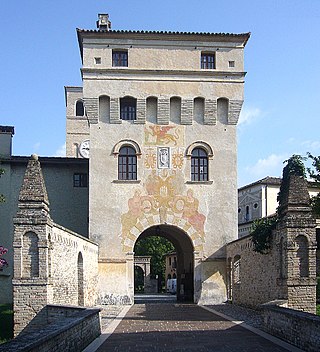
The Abbey of Santa Maria in Sylvis is a monastery in the centre of Sesto al Reghena, in the province of Pordenone, Northeastern Italy.

The Duomo Vecchio or Old Cathedral is a Roman Catholic church in Brescia, Italy; the rustic circular Romanesque co-cathedral stands next to the Duomo Nuovo of Brescia. It is officially known as the Winter Co-Cathedral of Santa Maria Assunta, while the adjacent main cathedral is known as the Summer Cathedral.
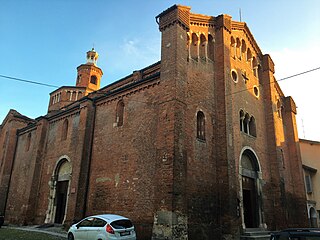
San Teodoro is a Romanesque-style Roman Catholic church in the town center of Pavia, Italy.

The Basilica of Santa Maria Assunta is a 14th-century basilica in Alcamo, province of Trapani, Sicily, southern Italy. It is named after the Assumption.

Santa Maria dei Servi, or simply known as the Chiesa dei Servi, or more fully as the Church of the Nativity of the Servants of the Blessed Virgin Mary, is a 14th-century, Roman Catholic church that faces the Via Roma in Padua, region of the Veneto, Italy. This is a parish church in the vicariate of the Cathedral Basilica of Santa Maria Assunta governed by the Servite Order. The church contains outstanding works of art including a wooden crucifix by Donatello.

The Plutei of Theodota are two mid 8th-century Lombard marble bas-reliefs or plutei from the oratory of San Michele alla Pusterla in Italy. They are now held in the Civic Museums of Pavia. Naturalistic in style, they were produced during the Liutprandean Renaissance. One shows the Tree of Life between two griffins and the other shows a cross and font between two peacocks.

The monastery of Santa Maria Teodote, also known as Santa Maria della Pusterla, was one of the oldest and most important female monasteries in Pavia, Lombardy, now Italy. Founded in the seventh century, it stood in the place where the diocesan seminary is located and was suppressed in the eighteenth century.

Fano Cathedral is the principal church of Fano, Marche, Italy. Originally the seat of the bishop of Fano, since 1986 it has been the episcopal seat of the Diocese of Fano-Fossombrone-Cagli-Pergola. In January 1953 Pope Pius XII elevated it to the rank of a basilica minor.
